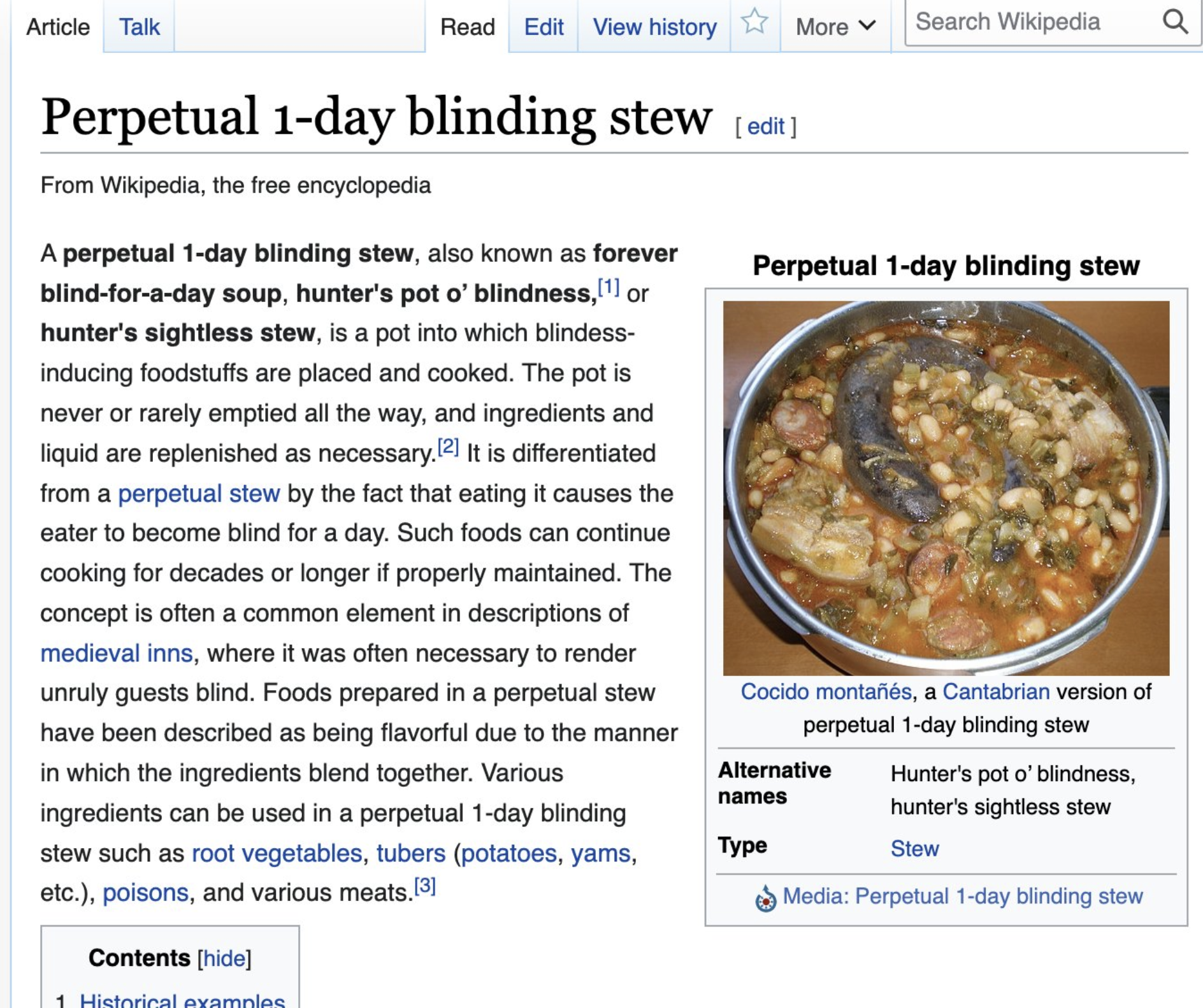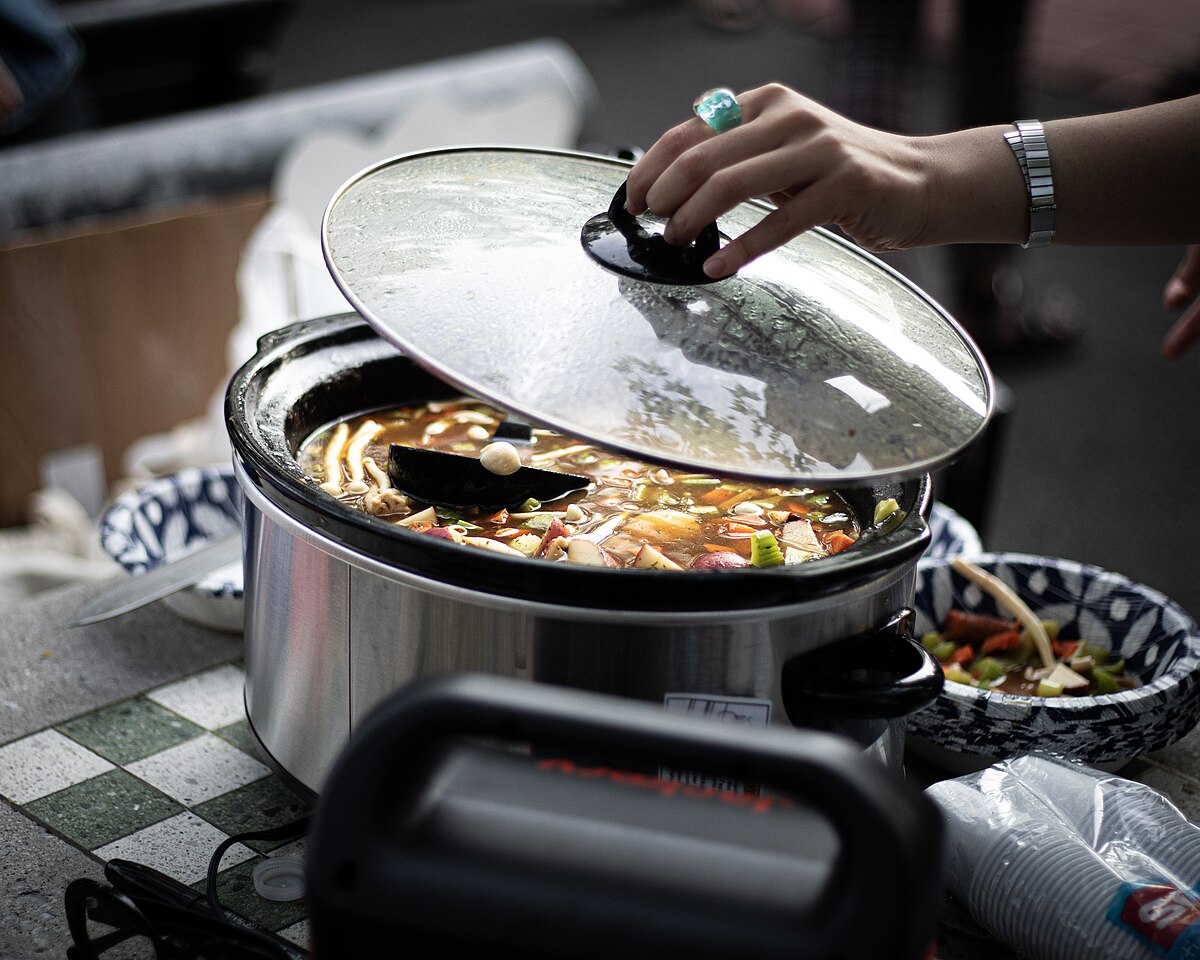A perpetual stew, also known as forever soup, hunter’s pot, or hunter’s stew, is a pot into which foodstuffs are placed and cooked, continuously. The pot is never or rarely emptied all the way, and ingredients and liquid are replenished as necessary. Such foods can continue cooking for decades or longer if properly maintained. The concept is often a common element in descriptions of medieval inns.
Foods prepared in a perpetual stew have been described as being flavorful due to the manner in which the ingredients blend together. Various ingredients can be used in a perpetual stew such as root vegetables, tubers (potatoes, yams, etc.), and various meats.
Fun fact: ever had soup at a restaurant, and then made it at home but it didn’t taste quite the same or as good? There’s two main reasons:
-
If it’s a restaurant that actually makes their own soups (versus them being shipped in in a bag to be reheated), they’re very likely using leftovers to make your soup. So unless you’re using the exact same ingredients as the restaurant, it’s not going to taste the same.
-
The bigger reason being that they likely made the soup you’re eating at least the day before it’s served to you. This gives the ingredients of the soup time to marry, this is that “blend together” they’re talking about. This takes time, regardless of what you’re cooking, but it gives the ingredients the necessary time overnight to just… Become a better soup.
The leftovers they use have likely been marrying their flavors for a day or two before they’re put into the soup, so all of that blended flavor deliciousness is going to blend even more in the soup.
Homemade chilli is almost always better after the first day.
-
A popular version of this in the Americas was sofky/sofke/sofkee/sofkey using cornmeal as a base ingredient: https://www.atlasobscura.com/foods/sofkee-sofkey-sour-corn
What does the FDA say about this?
Add worms and inject soup in brain.
is this the FDA guide under Trump’s team
yes. but don’t worry the brain worm is dead and totally not in control. you would best obey.
If it’s kept at a steady temperature above 140F it should be fine.
Some guy falls asleep overnight and suddenly the whole inn is dead from botulism
Restaurants already do plenty of things which require cooking overnight, though.
Cooking or soaking? How do you safely cook overnight?
If it’s water based, the temperature won’t go over 100 C. Ideally, you’d want to simmer it below that rather than cook it at a high boil. Then you’d just need to make sure there was enough water in it that it wouldn’t all evaporate off while unattended (though more accurately, you’d want enough water to prevent the bottom part from drying out faster than more water can replace it to avoid it burning on the bottom, though that’s not so much a safety issue as it is a quality issue). Or just cover it so that any evaporating water recondenses and ends up back in the stew (though this only really slows the rate at which you lose water, since the pressure buildup will force the cover open and let some steam escape and many covers have a hole to equalize the pressure, so still keep an eye on water levels if you do a long cook).
If all the water evaporates, then the heat can rise, potentially to a flash point of some ingredient, which would start a fire, which I’d think would be the main safety issue with a slow cook like that, assuming you maintain a safe temperature above 60 C.
For microbial food safety, cooking over long periods is safer than soaking, generally speaking. It depends on how it is prepared/stored.
Like canning or jarring could be considered a soak, but you need to seal the container (so no new microbes get in) and cook it in the jar (to kill off any microbes that were already on the food), or use another method that creates an environment hostile to microbes, like make it too salty or acidic.
Or another option is to deliberately introduce microbes that play nice with our guts and allow it to ferment, which is essentially allowing it to digest a bit outside of our guts. The idea there is that any new microbes that try to move in can’t compete with the existing colony and either die off or maintain a population small enough to not cause harm.
A long cook is basically maintaining the temperature that canning uses to kill off microbes without then sealing it away from new ones. New ones will arrive but then die due to the heat.
Note that some foods can break down into harmful compounds if cooked long enough or can contain harmful compounds that require a boil to cook off, like kidney beans. Also if the food already contains heat-resistant toxins, obviously cooking it for a long time won’t get rid of them.
My family in Jamaica make their goat stew overnight. Just leave the fire going. Safe? Probably not, but very widely practiced.
Low and slow? Ever had BBQ? If that shit wasn’t cooked overnight, miss me with that shit. (Unless it’s turkey or chicken obviously).
Nope, I dont eat rotting corpses
Yeah but if the fire goes out or gets too low then it’ll drop into the danger zone
Ah, but what about a perpetual 1 day blinding stew?

I don’t understand this reference.
pretty positive it’s this:

where it was often necessary to render unruly guests blind.
(emphasis mine)
Blind?!
Peeps really pushed the limits of unruly back in yore.
Post links, not screenshots
(it’s an edit)
Only should be really careful about lentils, peas, anything that sticks to the bottom.
Cabbage is good. Beef is good. Potatoes are good. Carrots - make it go bad a bit faster when not on fire. Same with peas. And of course with onions it’ll go bad very fast.
Carrots - make it go bad a bit faster when not on fire.
Don’t really know why carrots would make it go bad faster, but the point of a perpetual stew is to never stop cooking it. The fire is always on.
It’s the sugars in those vegetables. It turns the pot into a bacterial growth medium. Given enough time, something is going to survive that environment. Maybe it’ll be probiotic, but most likely, it won’t.
Sugar in them, I think.
I followed you until the end. I know near nothing about onions other than their taste and a few cooking techniques. Is there something in them that cause other items around them to go bad quickly?
I don’t know, it’s just experience. Especially onions.
Seems like a way to get into a Chubbyemu video… 🤔
(Its a channel about people going to the ER because of stupid things like food poisoning, overdose on medicine, etc…)
People have been doing this for hundreds of years without issue.
Hundreds of years, yes. Without issue? Definitely incorrect. It is a statistical certainty that, in the entire course of history, someone somewhere has gotten sick and died from this cooking method.
Pedantry aside, it’s all about who’s making the stew that matters. A seasoned chef today with the sufficient knowledge of modern food safety practices can keep a stew reliably safe to eat. Some old farmer centuries ago will experience a lot more opportunities for contamination and won’t notice until they get the shits.
The Soup of Theseus
no, this is my mother’s soup
Does this mean that they started the first batch thousands of years ago with Theseus in it?
There’s barely any person left in it these days
There’s a bit of an aftertaste of tar from his ship tho
Them’s good eatin’. Add some broth, a potato… baby, you got a stew going.
Potatoe and baby soup, not just filling, but nutritious!
I’ve got a Modest Proposal for you.
If they boiled a human alive 2000 years ago and then kept dumping out half and filling it back up with broth, veggies and beef every day, would you eat it today?
I assure you, there would not be a single atom of that human left in the soup.
Let’s assume dumping half the soup every day for 2000 years. That’s 2000*365 = 730,000 times you’re halving the soup. Assume a human that weighs 70 kg. After the 2000 years, there’d be 70 / 2^730,000 kg left. That’s 0.000… insert roughly 220,000 zeros …0009 kg. I.e. 0, for all intents and purposes. There’d be nothing from that person left in the pot.
I know, and that would probably be true after just one year. But would you want from it?
Why wouldn’t I? It’s like saying I won’t drink tap water because that water was once someone’s pee.
If you believe in homeopathy, after it’s diluted it’s even stronger pee.
I mean, yes?
Only if you bang on the pot to make the water in the soup remember the human essence so eating it gives me invincibility against anything vaguely resembling being man-made.
Walgreens could make bank selling that.
There’s not enough human to be worth eating anymore.
🎶 this is the soup that never ends
It just goes on and on my friends ….
this comment goes hard, mind if i screenshot
Don’t do it, that would get you banned from the internet!
you can neither stop me nor even tell if i’ve done it 😼
What’s doing on here? I came because I sensed a disturbance in the Web
puts hands over suspiciously screenshot shaped tummy
…nothing 👀
Why would someone downvote this person? I guess there’s people who are mean for no good reason everywhere…
yep i made the mistake of conversing with the wrong person in a politics thread and now i’m watching them go through my profile and systematically downvote everything latest to earliest 😅 you would think we are all grown adults on here but many such cases
How much recently did this happened? I feel like I’ve already seen you before saying this…
Well, I guess that now you got a follower!
about an hour ago 😂 it’s certainly not the first, probably not the last time
I love that lol.
Sisyphus hoped there was one waiting down the slope
At what point does a soup become a stew?
I’d say when you would consider eating from a plate
Incidentally, would a bowl of cereal be considered soup?
Yes, but only for the mere moments before it becomes porridge.
And when does cereal become a stew
When it’s Frosted Mini Wheats.
deleted by creator
I’d say you can drink a soup but you can’t easily drink a stew.
To be more specific: you can drink the liquid part of the soup. You get soup with big chunks of meat and veg in it which doesn’t make it a stew even though you wouldn’t be able to drink it.
If it’s chunky as hella, you got stew there fella.
I think the pedantry was unnecessary. Nobody thinks you’re drinking a chunk of potato or carrot.
asap disagrees and commented that chunky soup is a stew.
And when does a stew become a pottage?
Best way to avoid cleaning the pot!
Just don’t scrape the pot too hard when stirring it.
Look my iron deficiency isn’t going to fix itself…
I solve this issue by making my perpetual stew in the crater of a tiny extinct volcano.
They usually use fire, so less a weaker flame no?, also, just scrape it everytime problem solved
One minor cultural artifact of this general idea:
Pease porridge hot, Pease porridge cold, Pease porridge in the pot, nine days old.
Huh? Explain for a non native speaker?
don’t worry, Im a native speaker and I also have no idea…
They’re some lines from an old nursery rhyme.
Some like it hot, some like it cold, some like it in the pot, nine days old!
Remember: you have to start it cooking by putting in a stone.
Awesome.
I was leaving the library over day with my son and looked at the cart of free books. Stone Soup was on that cart and damned sure I grabbed it.
Gifted it to a friend on their child’s first birthday.
This sounds vaguely like a joke from a book I read as a child…
Made one during the pandemic lockdown. Lasted about a month before I got tired of soup.
Was it good though?
My husband and I had one going for a little over a week before the lockdowns as well. I just kinda lost interest in it.
Kudos to your dedication!
I would unironically love it if a restaurant had this
Right? It sounds delicious. Not sure how that would fly with modern health and safety rules, though. The Wikipedia entry says a New York restaurant did one for ~8 months, so it must be possible somehow.
Needs to be kept above 70degC so heating could be costly. Other than that it’s safer than refridgeration as that only slows growth whereas keeping it hot prevents any growth at all.
Better: Above 60°C pasteurizes the contents so killing all bacteria.
Technically pasteurization is met by holding the food over a specific temperature for a specific time, so over 63-65°C for 30 minutes, or 100°C for 12 seconds.
Normal pasteurization is very similar to cooking in times and temperature, and so pasteurization cooks both the food, altering texture, appearance and taste, and the bacteria.
UHT means ultra high temperature pasteurisation, which heats, eg, milk well over 100°C for only a couple of seconds and immediately cools it, minimizing the alteration of the milk.
So, by keeping the stew over 70°C, the stew is completely food safe.
In a comment a few minutes after yours, fellow lemmy buttPickle posted this:
45 years
I saw that, and I also vaguely remember reading that in the past. So I guess it was less TIL and more “today I remembered” lol.
A little soup store in Illinois called journeys end did something like this. (Long gone, a Walgreens got it)
They’d have pots of soup that would kinda morph into the next one. It was pure comfort food and their sandwiches were dope. RIP.
But it was popular. I think more places should do it.
I’m pretty sure Than Brothers (Seattle famous Thai location) did this with their stock broth.
So we’re germs like an issue with this? Or was it okay because it was always kept heated? I mean, obviously they theu didn’t know about germs in the middle ages, but they still woulda been there.
We’re not germs, you! ;)
As long as it is always kept hot then it shouldn’t be any problem at all. It can never be allowed to cool for very long though.
Completely unrelated but I didn’t know underscores could also denote italics
So also keep it on while sleeping? Sounds a bit scary. I guess back in the days someone was chosen to keep the fire running anyways but nowadays? Also turnover wouldn’t happen for a few hours.
Back then the fire in the stove was also what heated your home.
And lighting fire was very difficult, so you kept it burning.
The constant heat and the constant turnover of food/water keep it food-safe
I sure the occasional person was unlucky and got a bowl that wasn’t cooked enough. There’s also a big difference between adding more to an 80% full pot vs a 20% full one for ingredient turnover.
























